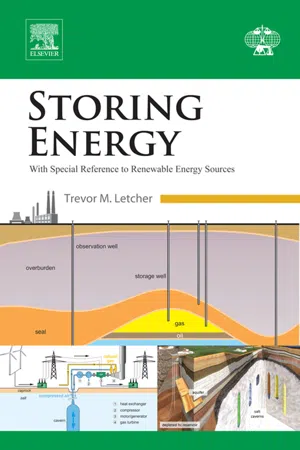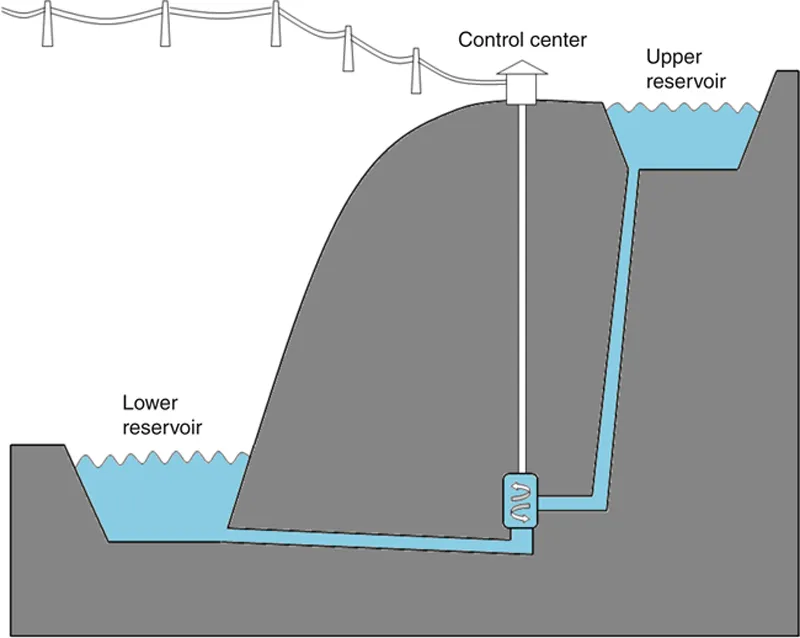
eBook - ePub
Storing Energy
with Special Reference to Renewable Energy Sources
- 590 pages
- English
- ePUB (mobile friendly)
- Available on iOS & Android
eBook - ePub
About this book
Energy Storage discusses the needs of the world's future energy and climate change policies, covering the various types of renewable energy storage in one comprehensive volume that allows readers to conveniently compare the different technologies and find the best process that suits their particularly needs.
Each chapter is written by an expert working in the field and includes copious references for those wishing to study the subject further. Various systems are discussed, including mechanical/kinetic, thermal, electrochemical and other chemical, as well as other emerging technologies. Incorporating the advancements in storing energy as described in this book will help the people of the world further overcome the problems related to future energy and climate change.
- Covers most types of energy storage that is being considered today, and allows comparisons to be made
- Each chapter is written by a world expert in the field, providing the latest developments is this fast moving and vital field
- Covers technical, environmental, social and political aspects related to the storing of energy and in particular renewable energy
Frequently asked questions
Yes, you can cancel anytime from the Subscription tab in your account settings on the Perlego website. Your subscription will stay active until the end of your current billing period. Learn how to cancel your subscription.
At the moment all of our mobile-responsive ePub books are available to download via the app. Most of our PDFs are also available to download and we're working on making the final remaining ones downloadable now. Learn more here.
Perlego offers two plans: Essential and Complete
- Essential is ideal for learners and professionals who enjoy exploring a wide range of subjects. Access the Essential Library with 800,000+ trusted titles and best-sellers across business, personal growth, and the humanities. Includes unlimited reading time and Standard Read Aloud voice.
- Complete: Perfect for advanced learners and researchers needing full, unrestricted access. Unlock 1.4M+ books across hundreds of subjects, including academic and specialized titles. The Complete Plan also includes advanced features like Premium Read Aloud and Research Assistant.
We are an online textbook subscription service, where you can get access to an entire online library for less than the price of a single book per month. With over 1 million books across 1000+ topics, we’ve got you covered! Learn more here.
Look out for the read-aloud symbol on your next book to see if you can listen to it. The read-aloud tool reads text aloud for you, highlighting the text as it is being read. You can pause it, speed it up and slow it down. Learn more here.
Yes! You can use the Perlego app on both iOS or Android devices to read anytime, anywhere — even offline. Perfect for commutes or when you’re on the go.
Please note we cannot support devices running on iOS 13 and Android 7 or earlier. Learn more about using the app.
Please note we cannot support devices running on iOS 13 and Android 7 or earlier. Learn more about using the app.
Yes, you can access Storing Energy by Trevor Letcher,Trevor M. Letcher in PDF and/or ePUB format, as well as other popular books in Technology & Engineering & Materials Science. We have over one million books available in our catalogue for you to explore.
Information
Part B
Electrical Energy Storage Techniques Gravitational/Mechanical/Thermomechanical
Chapter 2: Pumped Hydroelectric Storage
Chapter 3: Novel Hydroelectric Storage Concepts
Chapter 4: Advanced Rail Energy Storage: Green Energy Storage for Green Energy
Chapter 5: Compressed Air Energy Storage
Chapter 6: Compressed Air Energy Storage in Underground Formations
Chapter 7: Underwater Compressed Air Energy Storage
Chapter 8: A Novel Pumped Hydro Combined with Compressed Air Energy
Chapter 9: Liquid Air Energy Storage
Chapter 10: Flywheels
Chapter 2
Pumped Hydroelectric Storage
Chi-Jen Yang Center on Global Change, Duke University, Durham, NC, United States
Abstract
Pumped hydroelectric storage (PHES) is the most established technology for utility-scale electricity storage and has been commercially deployed since the 1890s. Since the 2000s, there has been revived interest in developing PHES facilities worldwide. Because most low-carbon electricity resources (e.g., wind, solar, and nuclear) cannot flexibly adjust their output to match fluctuating power demands, there is an increasing need for bulk electricity storage due to the increasing adoption of renewable energy. PHES has been the traditional way of storing energy. This chapter introduces PHES technology, its pros and cons, its historical developments, and its prospects.
Keywords
pumped hydroelectric storage
closed-loop
pumpback
peak shaving
1. Introduction
Pumped hydroelectric storage (PHES) is the most widely adopted utility-scale electricity storage technology. Furthermore, PHES provides the most mature and commercially available solution to bulk electricity storage. It serves to stabilize the electricity grid through peak shaving, load balancing, frequency regulation, and reserve generation.
Japan currently has the largest installed PHES capacity in the world [1], followed by China [2] and the United States [3]. China currently has the most aggressive plan to expand PHES installation, with over 27-GW capacity under construction as of December 2015, and much more planned. China is expected to surpass Japan in installed PHES capacity by 2018. Table 2.1 shows the installed PHES capacities in major countries [2–5].
Table 2.1
Installed Pumped Hydroelectric Storage (PHES) Capacities
| Country | Installed PHES capacity/MW |
| Japan | 27 438 |
| China | 21 545 |
| United States | 20 858 |
| Italy | 7 071 |
| Spain | 6 889 |
| Germany | 6 388 |
| France | 5 894 |
| India | 5 072 |
| Austria | 4 808 |
| Korea, South | 4 700 |
| United Kingdom | 2 828 |
| Switzerland | 2 687 |
| Taiwan | 2 608 |
| Australia | 2 542 |
| Poland | 1 745 |
| Portugal | 1 592 |
| South Africa | 1 580 |
| Thailand | 1 391 |
| Belgium | 1 307 |
| Russia | 1 246 |
| Czech Republic | 1 145 |
| Luxembourg | 1 096 |
| Bulgaria | 1 052 |
| Iran | 1 040 |
| Slovakia | 1 017 |
| Argentina | 974 |
| Norway | 967 |
| Ukraine | 905 |
| Lithuania | 900 |
| Philippines | 709 |
| Greece | 699 |
| Serbia | 614 |
| Morocco | 465 |
| Ireland | 292 |
| Croatia | 282 |
| Slovenia | 185 |
| Canada | 174 |
| Romania | 53 |
| Chile | 31 |
| Brazil | 20 |
A PHES facility is typically equipped with pumps and generators connecting an upper and a lower reservoir (Fig. 2.1). The pumps utilize relatively cheap electricity from the power grid during off-peak hours to move water from the lower reservoir to the upper one to store energy. During periods of high electricity demand (peak hours and when electricity is expensive), water is released from the upper reservoir to generate power at a higher price.

Figure 2.1 Pumped hydroelectric storage diagram.
There are two main types of PHES facilities: (1) pure or off-stream PHES, which rely entirely on water that was previously pumped into an upper reservoir as the source of energy; (2) combined, hybrid, or pumpback PHES, which use both pumped water and natural stream flow water to generate power [4]. Off-stream PHES is sometimes also referred to as “closed-loop” systems. However, some may define closed-loop systems more strictly as being entirely isolated from natural ecosystems. The US Federal Energy Regulatory Commission defines closed-loop pumped storage as projects that are not continuously connected to a naturally flowing water feature [5].
The efficiency of PHES varies quite significantly due to the long history of the technology and the long life of a facility. The roundtrip efficiency (electricity generated divided by the electricity used to pump water) of facilities with older designs may be lower than 60%, while a state-of-the-art PHES system may achieve over 80% efficiency.
2. Pros and cons
By storing electricity, PHES facilities can protect the power system from outages. Coupled with advanced power electronics, PHES systems can also reduce harmonic distortions and eliminate voltage sags and surges. Of all ...
Table of contents
- Cover
- Title page
- Table of Contents
- Copyright
- List of Contributors
- Preface
- Part A: Introduction
- Part B: Electrical Energy Storage Techniques Gravitational/Mechanical/Thermomechanical
- Part C: Electrochemical
- Part D: Thermal
- Part E: Chemical
- Part F: Integration
- Part G: International Issues and the Politics of Introducing Renewable Energy Schemes
- Subject Index